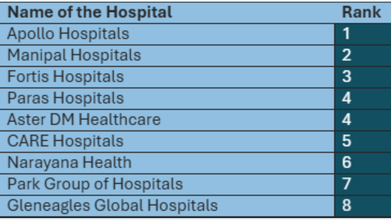- Health Conditions A-Z
- Health & Wellness
- Nutrition
- Fitness
- Health News
- Ayurveda
- Videos
- Medicine A-Z
- Parenting
- Web Stories
Times Now Network Ranks India’s Top Hospitals, Survey Reveals Performance Across 16 Cities

Credits: Canva
Times Now Network conducted a survey where different hospital chains were ranked to understand how well the hospitals and healthcare institutions in India work and if the services offered by them adhere to the benchmarks given by NABH, under the Quality council of India.
The parameters on which these hospitals were judged were VFM or value for money, quality of treatment, team of consultants and doctors, infrastructure, hygiene and cleanliness, faculties and public convenience, and innovation and research facilities. The factual scores were submitted by the institutions and held 60% weightage, while the perceptual scores held a weightage of 40% weightage.
The institutes were asked to submit details and information including verification and validation by a research agency. The scores were also based on the perceptual survey, with a sample size of 3000, conducted across 16 cities, and then the final scores were calculated based on the weightages of the different parameters. Word of mouth is also considered in the survey as it holds a critical point in decision making. The results were announced in the latest India Health Summit, held at Taj Palace, Delhi on October 4, 2025.
The Ranks Are As Followed

The survey covered various critical care specialties, including cardiology, neurology, nephrology, oncology, obstetrics and gynecology, pediatrics, urology, gastroenterology, and emergency and trauma. Among the lifestyle categories were dental health, orthopedics, diabetes care, IVF & fertility, and cosmetic and plastic surgery.
The sample size was across 12 cities, which included 3300 doctors and patients with the ratio of 40:60. It was as followed:
- Delhi NCR had a sample size of 300
- Mumbai had a sample size of 300
- Chennai had a sample size of 300
- Kolkata had a sample size of 300
- Bengaluru had a sample size of 300
- Hyderabad had a sample size of 300
- Ahmedabad had a sample size of 250
- Pune had a sample size of 250
- Bhubaneswar had a sample size of 250
- Jaipur had a sample size of 250
- Lucknow had a sample size of 250
- Kochi had a sample size of 250
In addition to this, for Factual Survey, over 1500 hospitals across India were targeted and connected.
The main objective of this survey was to provide clarity that usually lacks in other ranking as they do not detail out on how the hospitals is performing better than others and on what parameters and hence it is difficult for patients to take an informed decision.
Chocolate Product Recalled In UK Over Potentially Fatal Risk

Credits: Canva
M&S Chocolate Honeycomb Recall: The Food Standards Agency (FSA) has issued a “do not eat” warning after a popular Marks & Spencer chocolate product was found to contain a known allergen not listed on the packaging. The item has been pulled from shelves due to potential health risks, as the allergy information is inaccurate. In such situations, the FSA releases an Allergy Alert. The chocolate may contain peanuts, which are not mentioned on the label, posing a health risk to anyone with peanut allergies or sensitivities.
Chocolate Honeycomb Recall: Which Product Has Been Pulled?
Marks & Spencer is recalling the M&S Milk Chocolate Honeycomb because it may contain undeclared peanuts. This presents a possible health danger for anyone with a peanut allergy or intolerance. Product details are as follows: M&S Milk Chocolate Honeycomb, 120g pack, Lot Number 5242, Best Before May 12, 2026. The FSA advises anyone with a peanut allergy not to consume the product and to return it to the nearest M&S store for a full refund.
M&S stated, “Customer safety is our highest priority, and we treat all food production issues with utmost seriousness. In a precautionary step, we are recalling Milk Chocolate Honeycomb due to the potential presence of undeclared peanuts in a small number of packs.” To identify affected packs, consumers should check for the best-before date May 12, 2026, and lot number 5242.
What Is An Allergy Alert?
Sometimes a food product has an issue that makes it unsafe for sale. It may be “withdrawn” (taken off shelves) or “recalled” (consumers are asked to return it). Recalls often happen if allergy information is missing or incorrect, or if another health risk is present. When such a risk exists, the FSA issues an Allergy Alert. Past incidents of serious allergic reactions have highlighted how dangerous accidental exposure can be.
In a similar recent case, Aldi recalled certain tubs of Gianni’s Cheeky Monkey Ice Cream because they contained undeclared wheat (gluten), not mentioned on the label. This posed a health risk for people with coeliac disease or a wheat allergy or intolerance, according to the FSA.
How To Check Your Pantry
Consumers are advised to carefully check their cupboards and pantries for any packs of M&S Milk Chocolate Honeycomb with the lot number 5242 and best-before date May 12, 2026. Even a single pack should not be consumed. If you are unsure, it is safer to dispose of the product or return it to the store.
What To Do If You’ve Consumed The Product
For people who have accidentally eaten the chocolate and experience symptoms of an allergic reaction such as swelling, hives, difficulty breathing, nausea, or vomiting, it’s crucial to seek medical attention immediately. Those with known severe allergies should follow their emergency action plan and carry an epinephrine auto-injector if prescribed.
The FSA encourages consumers to report any adverse reactions to food products, which helps authorities monitor risks and ensure timely recalls. Staying informed through FSA alerts or the brand’s official channels is essential for safety.
FDA Recalls 16 Cinnamon Brands Over High Lead Levels; All You Need To Know

Credits: CANVA
FDA ground cinnamon recall: Certain varieties of one of America’s most common spices, cinnamon, may now pose a risk to your health. Over the past week, the U.S. Food and Drug Administration has flagged four more producers of ground cinnamon found to have unusually high lead content. With these additions, a total of 16 brands are now on the agency’s watchlist for elevated lead levels.
According to the FDA, “prolonged consumption of these products may be unsafe and could raise lead levels in the blood.”
The agency also noted that it has requested all the companies involved to carry out voluntary recalls of the affected products.
Cinnamon Recall FDA: Popular Spice Brands Found With High Lead LevelsThe FDA reported that these 16 brands contain elevated lead levels ranging from 2.03 parts per million (ppm) to 7.68 ppm, posing potential health risks.
- Roshni (2.268 ppm)
- HAETAE (4.60 ppm)
- Durra (2.44 ppm)
- Wise Wife (2.49 ppm)
- Jiva Organics (2.29 ppm)
- Super Brand (7.68 and 6.60 ppm)
- Asli (2.32 ppm)
- El Chilar (3.75 and 7.01 ppm)
- Marcum (2.22 and 2.14 ppm)
- SWAD (2.89 ppm)
- Supreme Tradition (2.37 ppm)
- Compania Indillor Orientale (2.23 ppm)
- ALB Flavor (3.93 ppm
- Shahzada (2.03 ppm)
- Spice Class (2.04 ppm)
- La Frontera (2.66 ppm)
How Lead Consumption Can Harm Your Health
The FDA states that there is no safe level of lead exposure. Prolonged contact especially over months can lead to serious health issues, particularly in young children.
According to the agency, high lead exposure during pregnancy, infancy, and early childhood can result in neurological damage, including learning difficulties, behavioral issues, and reduced IQ.
The World Health Organization (WHO) also warns that lead can cause long-term problems in adults, such as high blood pressure, heart disease, and kidney damage.
Symptoms of Lead Exposure
The symptoms of lead exposure often resemble other conditions, making them easy to overlook. The FDA notes that most people show no immediate signs of lead toxicity.
The severity of health effects depends on the amount, frequency, and duration of exposure, along with a person’s age and existing lead contact from other sources.
Children with low-level exposure may not display obvious symptoms but could experience learning difficulties, lower IQ, and behavior changes over time. At higher levels, the Centers for Disease Control and Prevention (CDC) lists the following possible symptoms:
- Metallic taste
- Abdominal pain, nausea, or vomiting
- Diarrhea or constipation
- Fatigue, irritability, or weakness
- Headache and dehydration
- Loss of appetite
- Memory problems
- Tingling or pain in hands or feet
What Should Consumers Do With Recalled Cinnamon?
The FDA urges consumers who purchased Wise Wife Ground Cinnamon to return it to the store for a full refund. Those seeking more information can contact SLR Food Distribution at 516-437-3782.
NHS Issues Warning Across UK About Unique Covid Symptom Lasting More Than 60 Minutes

Credits: Canva
People across the UK are being advised to stay alert for a symptom that lasts more than an hour, which could indicate a COVID-19 infection. According to the latest figures from the UK Health Security Agency (UKHSA), coronavirus cases are once again climbing in hospitals throughout England. The data shows that the XFG variant, also known as the Stratus strain, has now become the dominant form of the virus. Here’s what the NHS has said about this unusual symptom and what to look out for.
New Covid Strain Shows Unique Symptom Lasting More Than 60 Minutes in the UK
To help prevent further spread of COVID-19, the NHS is reminding people of the key symptoms to watch for. On its official site, the health service highlights one particular sign that can persist for more than an hour, a new, continuous cough. The NHS explains: “This means coughing frequently for over an hour, or having three or more coughing episodes within a 24-hour period.”
It further notes that these symptoms can resemble those of common colds or the flu. “Most people recover within a few weeks, though in some cases, recovery may take longer. For others, the illness can be more severe, and symptoms may linger,” the advice adds.
The NHS recommends staying home and limiting contact with others if you or your child have symptoms and either:
- Have a high temperature
- Don’t feel well enough to work, study, or carry out daily activities
Stratus: The Most Dominant Covid Strain in the UK
Health experts have confirmed that the XFG variant, referred to as Stratus, is currently the most common strain circulating in the UK. In previous weeks, the NB.1.8.1 strain, known as Nimbus, had also been widely detected.
In a recent statement, the UKHSA cautioned that these newer variants may cause symptoms such as a hoarse voice or a “particularly painful” sore throat in addition to standard COVID-19 signs. While there are no longer any government-enforced rules about isolation, the NHS continues to recommend caution and responsible behaviour if you test positive for the virus.
Stratus Covid Symptoms to Look Out For
Other COVID-19 symptoms to monitor include:
- High temperature or chills (feeling hot to the touch on the chest or back)
- Change or loss of smell or taste
- Shortness of breath
- Fatigue or exhaustion
- Body aches
- Headache
- Sore throat
- Blocked or runny nose
- Loss of appetite
- Diarrhoea
- Nausea or vomiting
Have You Got a Razor-Blade Sore Throat?
It’s normal for viruses to evolve as they move between people. When enough changes occur, new versions, or variants emerge. Recent reports suggest that the latest strains may cause distinctive signs such as a hoarse voice or a sore throat described as feeling like “razor blades.”
COVID-19 can still produce a wide range of symptoms, from headaches and nasal congestion to exhaustion, making it easy to confuse with the flu or a cold. If you believe you have COVID-19, try to avoid close contact with vulnerable individuals and remain at home whenever possible.
If you must go out, it is advised to wear a face covering. Regular hand washing and safely discarding used tissues can help stop the virus from spreading. For throat discomfort, the NHS suggests staying hydrated and taking a teaspoon of honey for relief.
According to the Royal College of General Practitioners, COVID-19 cases are currently rising across the UK, particularly among children and older adults.
© 2024 Bennett, Coleman & Company Limited

